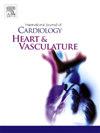Transcatheter versus surgical aortic valve replacement in patients with aortic stenosis with a small aortic annulus: A meta-analysis with reconstructed time to event data
IF 2.5
Q2 CARDIAC & CARDIOVASCULAR SYSTEMS
引用次数: 0
Abstract
Background
Aortic stenosis (AS) remains a prevalent and serious global health concern, exacerbated by an aging population worldwide. This valvular disease, when symptomatic and without appropriate intervention, severe AS can drastically reduce life expectancy. In our systematic review and meta-analysis, we aim to synthesize available evidence to guide clinical decision-making by comparing the performance of TAVR and SAVR, specifically in patients with severe AS and a small aortic annulus.
Methods
We searched PubMed, EMBASE, Cochrane, Web of Science, and Scopus from inception till May 2024. The risk ratio (RR) and mean difference (MD) with a 95 % confidence interval (CI) are provided as effect size estimates, with all analyses being conducted using RevMan 5.4.
Results
Eleven studies with 3,670 patients were included. TAVR significantly increased the risk of 2-year new permanent pacemaker implantation (PPI) (RR = 2.42; 95 % CI: [1.70–3.44], P < 0.0001) and major vascular complications (RR = 3.73; 95 % CI: [1.98–6.99], P < 0.0001) than SAVR. However, TAVR significantly decreased the risk of patient-prosthesis mismatch (PPM) (RR = 0.56; 95 % CI: [0.48–0.65], P < 0.00001) and new-onset atrial fibrillation (AF) (RR = 0.31; 95 % CI: [0.23–0.41], P < 0.00001). Also, SAVR reduced the risk of paravalvular leak (PVL) (RR = 3.35; 95 % CI: [1.79–6.27], P = 0.0002).
Conclusion
TAVR had a significantly reduced risk of PPM and new-onset AF but with increased PPI and vascular complications. Also, TAVR significantly improved EOA and iEOA. Furthermore, SAVR had less risk of PVL, and better LVEF improvement at predischarge. Therefore, TAVR and SAVR remain valid alternatives, and decisions should be based on anatomy of the annulus and aortic root,operative risk, and comorbidities.
经导管与手术主动脉瓣置换术治疗伴有小主动脉环的主动脉狭窄患者:一项具有重建时间到事件数据的meta分析。
背景:主动脉瓣狭窄(AS)仍然是一个普遍而严重的全球健康问题,并因全球人口老龄化而加剧。这种瓣膜疾病,如果没有适当的干预,严重的AS会大大降低预期寿命。在我们的系统综述和荟萃分析中,我们的目标是通过比较TAVR和SAVR的表现来综合现有证据,以指导临床决策,特别是在严重AS和小主动脉环患者中。方法:检索PubMed、EMBASE、Cochrane、Web of Science和Scopus数据库,检索时间为建站至2024年5月。以95%置信区间(CI)的风险比(RR)和平均差(MD)作为效应大小估计,所有分析均使用RevMan 5.4进行。结果:纳入11项研究,共3670例患者。TAVR显著增加2年新的永久性起搏器植入术(PPI)的风险(RR = 2.42;95% CI: [1.70-3.44], P < 0.0001)和主要血管并发症(RR = 3.73;95% CI: [1.98 ~ 6.99], P < 0.0001)高于SAVR。然而,TAVR显著降低了患者-假体不匹配(PPM)的风险(RR = 0.56;95% CI: [0.48-0.65], P < 0.00001)和新发心房颤动(AF) (RR = 0.31;95% ci: [0.23-0.41], p < 0.00001)。此外,SAVR降低了瓣旁漏(PVL)的风险(RR = 3.35;95% ci: [1.79-6.27], p = 0.0002)。结论:TAVR显著降低了PPM和新发房颤的风险,但增加了PPI和血管并发症。TAVR显著改善了EOA和iEOA。此外,SAVR具有较低的PVL风险和较好的LVEF改善。因此,TAVR和SAVR仍然是有效的选择,决定应基于环和主动脉根的解剖结构、手术风险和合并症。
本文章由计算机程序翻译,如有差异,请以英文原文为准。
求助全文
约1分钟内获得全文
求助全文
来源期刊

IJC Heart and Vasculature
Medicine-Cardiology and Cardiovascular Medicine
CiteScore
4.90
自引率
10.30%
发文量
216
审稿时长
56 days
期刊介绍:
IJC Heart & Vasculature is an online-only, open-access journal dedicated to publishing original articles and reviews (also Editorials and Letters to the Editor) which report on structural and functional cardiovascular pathology, with an emphasis on imaging and disease pathophysiology. Articles must be authentic, educational, clinically relevant, and original in their content and scientific approach. IJC Heart & Vasculature requires the highest standards of scientific integrity in order to promote reliable, reproducible and verifiable research findings. All authors are advised to consult the Principles of Ethical Publishing in the International Journal of Cardiology before submitting a manuscript. Submission of a manuscript to this journal gives the publisher the right to publish that paper if it is accepted. Manuscripts may be edited to improve clarity and expression.
 求助内容:
求助内容: 应助结果提醒方式:
应助结果提醒方式:


